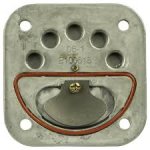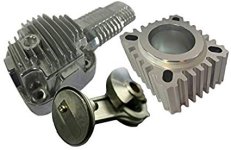strantor
Platinum Member
I want a whisper quiet high volume, high pressure air compressor. Something like this or a pair of these. Since it's just a want, not a need, I can't justify spending the money (nor do I even have the money). And since I like building things, I thought maybe I would make one.
Before I go further, let me clarify: I want to turn an automobile engine into a piston air compressor. Yes it can be done; there are examples all across the internet. Yes I know it will require modifications to the valves, et. al. And I want to turn the whole engine into a compressor (electric driven); not the monoblock 4 combustion cylinders/4 compression gas-powered compressor scheme.
I have a 2005 Yukon Denali in my driveway with a blown 6.0 V8 engine; threw a rod through the side of the block. By my (probably bad) math, if the other 7 cylinders are intact, then I should be able to get 25cfm @ 150psi out of it right around 1385rpm. By my (probably bad) logic, if a GM V8 engine idling high around the target RPM is quiet enough to carry on a conversation beside it while there are >5500 explosions per minute occurring inside, then it should be totally possible (possibly by reusing/reconfiguring the donor vehicle's intake & exhaust components) to make the resulting compressor equally or more quiet in the absence of those explosions.
My reason for posting is, I've never had enough time or curiosity to dissect a lost cause engine for science and rate the damage to the other cylinders on a 1-10 scale, nor do I know anyone else who has either. Has anyone here? What are the odds that the other cylinders are good? I suppose a compression test would tell me, but before I can do that, I'll have to at minimum drop the oil pan and clear the shrapnel from around the crank, and I don't even know if it's worth the time. Could I do it without rotating the engine? Could I just hook an air line to each cylinder one at a time from the little 1hp compressor I've already got, inflate it to max PSI, block it off, and see if it bleeds down?
Also I've never built a compressor from an engine, and I know at least one person on this forum has, and I'm curious how far off base I am about the pressure, flow, RPM figures and the noise level.
Before I go further, let me clarify: I want to turn an automobile engine into a piston air compressor. Yes it can be done; there are examples all across the internet. Yes I know it will require modifications to the valves, et. al. And I want to turn the whole engine into a compressor (electric driven); not the monoblock 4 combustion cylinders/4 compression gas-powered compressor scheme.
I have a 2005 Yukon Denali in my driveway with a blown 6.0 V8 engine; threw a rod through the side of the block. By my (probably bad) math, if the other 7 cylinders are intact, then I should be able to get 25cfm @ 150psi out of it right around 1385rpm. By my (probably bad) logic, if a GM V8 engine idling high around the target RPM is quiet enough to carry on a conversation beside it while there are >5500 explosions per minute occurring inside, then it should be totally possible (possibly by reusing/reconfiguring the donor vehicle's intake & exhaust components) to make the resulting compressor equally or more quiet in the absence of those explosions.
My reason for posting is, I've never had enough time or curiosity to dissect a lost cause engine for science and rate the damage to the other cylinders on a 1-10 scale, nor do I know anyone else who has either. Has anyone here? What are the odds that the other cylinders are good? I suppose a compression test would tell me, but before I can do that, I'll have to at minimum drop the oil pan and clear the shrapnel from around the crank, and I don't even know if it's worth the time. Could I do it without rotating the engine? Could I just hook an air line to each cylinder one at a time from the little 1hp compressor I've already got, inflate it to max PSI, block it off, and see if it bleeds down?
Also I've never built a compressor from an engine, and I know at least one person on this forum has, and I'm curious how far off base I am about the pressure, flow, RPM figures and the noise level.

